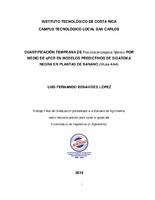Cuantificación temprana de Pseudocercospora fijiensis por medio de qpcr en modelos predictivos de Sigatoka negra en plantas de banano (Musa AAA)
Resumen
Banana crops are susceptible to diseases caused by bacteria, phytonematodes, as well as fungi, including Pseudocercospora fijiensis, which is the causing agent of the disease known as Black Sigatoka (black leaf streak). This disease is widely distributed throughout the world and is considered to be the main phytosanitary problem in banana production, causing damages such as: leafs loss, premature ripening of the fruit, and loss of cluster weight, among others. Ascospores are the main means of infection due to the easy dissemination by wind and water; they enter stomata once they are deposited on the underside of the cigar leaf, where conditions of high rainfall and temperatures between 26-28 °C directly influence the development of the disease. Visual tools are most used for evaluating variables such as the weighted average of infection (PPI), sick younger leaf (HMJE), younger leaf spotted (HMJM), younger leaf free of stretch marks (HMJLE) and state of evolution of the disease, which are the most used for the programming of application of protectant and systemic fungicides. On the other hand, models for predicting of severity have been developed by integrating climatic variables such as precipitation, relative humidity, temperature and solar radiation. In recent decades, studies have been conducted for the detection and quantification of the fungus P. fijiensis in naturally infected leaves with the design of specific markers for the ITS and β-tubulin regions through RT-PCR ( Polymerase chain reaction).
Descripción
Tesis (Licenciatura en Ingeniería en Agronomía) Instituto Tecnológico de Costa Rica, Escuela de Agronomía, 2019.


